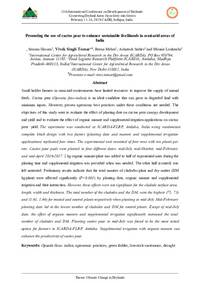Promoting the Use of Cactus Pear to Enhance Sustainable Livelihoods in Semi-arid Areas of India

Authors:
Small holder farmers in semi-arid environments have limited resources to improve the supply of animal feeds. Cactus pear (Opuntia ficus-indica) is an ideal candidate that can grow in degraded land with minimum inputs. However, proven agronomy best practices under these conditions are needed. The objectives of this study were to evaluate the effect of planting date on cactus pear canopy development and yield and to evaluate the effect of organic manure and supplemental irrigation applications on cactus pear yield. The experiment was conducted at ICARDA-FLRP, Amlaha, India using randomized complete block design with two factors (planting date and manure and supplemental irrigation applications) replicated four times. The experimental unit consisted of four rows with ten plants per row. Cactus pear pads were planted in four different dates: mid-July, mid-October, mid-February and mid-April 2016-2017. 2 kg organic manure/plant was added to half of exponential units during the planting time and supplemental irrigation was provided when was needed. The other half (control) was left untreated. Preliminary results indicate that the total number of cladodes/plant and dry matter (DM kg/plant) were affected significantly (P<0.001) by planting date, organic manure and supplemental irrigation and their interaction. However, these effects were not significant for the cladode surface area, length, width and thickness. The total number of the cladodes and the DM were the highest (75, 73) and (1.61, 1.64) for treated and control plants respectively when planting in mid-July. Mid-February planting date led to the lowest number of cladodes and DM for control plants. Except of mid-July date, the effect of organic manure and supplemental irrigation significantly increased the total number of cladodes and DM. Planting cactus pear in mid-July was found to be the most suited option for farmers in ICARDA-FLRP, Amlaha. Supplemental irrigation with organic manure can enhance the productivity of cactus pear
